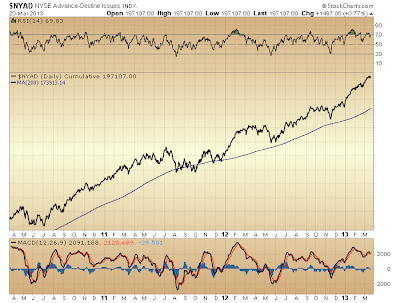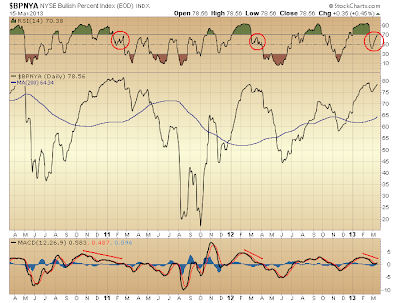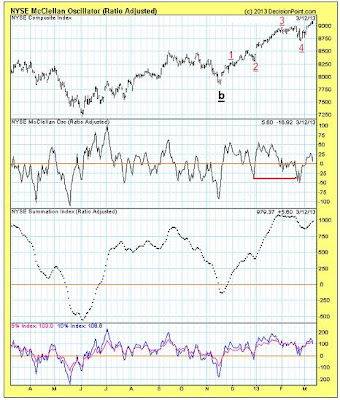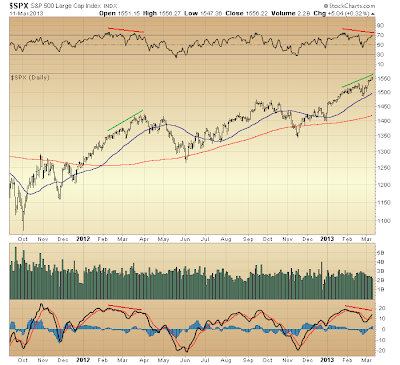First, a public service warning...
Get ready for a sharp increase in your contribution to the cash flow flooding into a hopelessly insolvent banking system hooked on derivatives and evidently in need of much more capital than Capo Confetti can shovel into its coffers.
Now, to pull this off, they'll need to keep all the ninnies at CNBC squeaking in ecstasy over a stock market dominated by weak hands that simply cannot afford to further curtail participation to any degree sending volume crashing and accelerating the long running liquidity drain that has been dogging U.S. equities markets these past few years. This means more black magic conjuring fantastic illusions of "value in demand" probably lies in store here. In other words, a market pullback of any consequence is likely to be delayed. Yet once this no longer can be forestalled, we might expect a bloodletting of far greater consequence, and this
sooner than we thus far have assumed.
If we take last week's Elliott Wave view suggesting a "c" wave up has been unfolding since mid-November 2012 bottom—this completing an a-b-c [corrective] wave up from early-October 2011 bottom—and further dissect the manner in which this "c" wave is seeing increasing underlying technical weakness develop coincident with its formation, we can set aside certain expectations laid forth both yesterday and Friday, and suppose these are being met in other representative ways, while illuminating the reason why conditions we otherwise were expecting are likely to be defied.
To wit, coincident with formation of five component waves forming wave
c up from mid-November 2012 bottom we were expecting both daily RSI and MACD to display increasing underlying weakness during formation of the 4th wave versus the 2nd. Given this, Friday's assumption was that, the 4th wave of wave
c, unfolding since approximately February 20th, likely would continue its formation over coming days. Its further development was to see an impending declining leg whose effect likely would sink daily RSI and MACD below levels these measures respectively registered at the late-December 2012 conclusion of the 2nd wave of wave
c. We can set this expectation aside for now, however.
Indeed, we already see this anticipated condition displayed via the NYSE McClellan Oscillator. Likewise, increasing underlying technical weakness is more broadly revealed here, as well. In fact objective basis for claiming "something's not right" (as the assumed place within the larger
Elliott wave count off March '09 bottom advises) is decidedly substantiated by the McClellan Oscillator's ever diminishing print, this even since well before the mid-November 2012 bottom from which wave
c began.
There are other technical measures likewise suggesting the 4th wave of wave
c in fact already is completed (this on February 26th). The
NYSE advance-decline differential, as well as the
new 52-week high-low differential reveal the same [typical] 4th wave versus 2nd wave technical deterioration as does the McClellan Oscillator above. Ditto the
CBOE put/call ratio.
So, we can assume the 5th wave of wave
c in fact is now well underway. This also means it'll all be over soon. That is all the mindless banter claiming central bank omniscience and sound reasoning.
Now, why was it Capo Confetti last September became compelled to apply Fed grease until kingdom come? Markets weren't buoyant enough? Hardly! Uber leveraged albatrosses with highly correlated credit derivatives exposure needed yet further risk-taking encouragement? Probably.
And that is why yesterday's anticipation for a spike in the Volatility Index exceeding its late-December 2012 peak probably is unlikely. The bankrupt pricks and their misguided daddy simply cannot easily endure even the least scare at this point. Yet neither is a fearful posture evidently warranted, now that Capo Confetti and his fleet of Chinook helicopters evidently are operating under code red conditions. Recall how the market's decline into mid-November 2012 barely nudged the VIX higher. We might better fathom why now. Likewise should we gain better insight into why pinning VIX to the floor is both desirable, and more to the point, probably utterly necessary. So, forget about the Volatility Index exceeding its late-December 2012 peak anytime between now and completion of wave
c. Given dire circumstance just about every central bank on the planet has had no choice but confirm with a vengeance, far greater is likelihood the next VIX spike coincides with central banks being prostrated in some significantly upsetting manner.
It's along this same line of thinking Friday's expectation per daily RSI and MACD is better dashed. Well enough is the fact a "c" wave is an Elliott third wave, which typically is the most dynamic Elliott wave. If by the measures of daily RSI and MACD 4th wave versus 2nd wave technical deterioration is not displayed in the present instance, we can count this evidence confirming an Elliott third wave (in this case wave
c). Gravy is added rationale supplied above uncovering the likely reason for a quiescent VIX of late. The market's present capacity to endure a scare (such as would commensurately sink RSI and MACD) simply is razor thin.
So, in closing we should ponder the evidence and wonder whether protagonists of a hopelessly insolvent banking system might be scheming to create an energy-induced contraction of the physical economy whose principal purpose might venture accelerating the availability of assets on the cheap. Let's not forget a woefully fragile financial economy likely to be squeezed, as well. All those bad marionettes in Washington flying off the reservation with increasing talk about breaking up big banks then might be given pause, while a new, orchestrated swindle viciously precipitates systemically threatening chaos conducive to hastening further consolidation of both physical and financial assets and rejuvenates Team Fraud's imperative to "save" the world from yet another Great Depression...

* * * * *
© The Risk Averse Alert — Advocating a patient, disciplined approach to stock market investing. Overriding objective is limiting financial risk. Minimizing investment capital loss is a priority.
Analysis centers on the stock market's path of least resistance. Long-term, this drives a simple strategy for safely investing a 401(k) for maximum profit. Intermediate-term, investing with stock index tracking-ETFs (both their long and short varieties) is advanced. Short-term, stock index options occasionally offer extraordinary profit opportunities when the stock market is moving along its projected path.
Nothing is set in stone. Nor is the stock market's path of least resistance always known. More often than not, there are no stock index option positions recommended.
 There's an easy way to boost your investment discipline...
There's an easy way to boost your investment discipline...
Get Real-Time Trade Notification!

 There's an easy way to boost your investment discipline...
There's an easy way to boost your investment discipline...


























